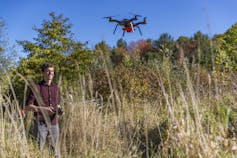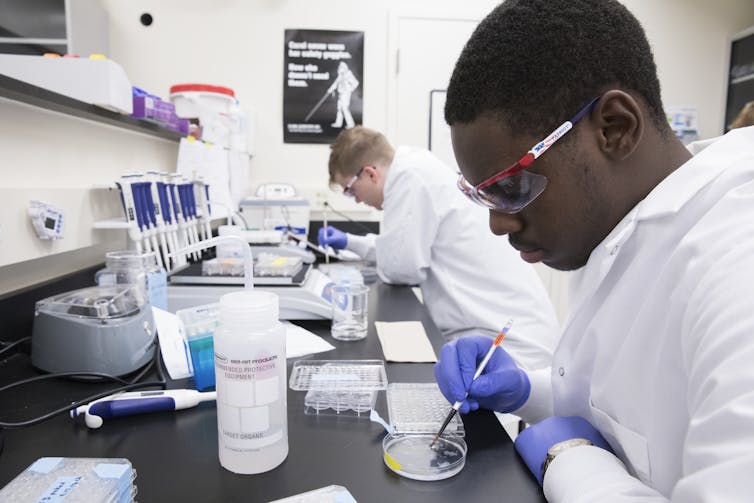At these colleges, students begin serious research their first year
- Written by Nancy Stamp, Professor, Binghamton University, State University of New York
Rat brains to understand Parkinson’s disease. Drones to detect plastic landmines. Social media to predict acts of terrorism.
These are just a few potentially lifesaving research projects that students have undertaken in recent years at universities in New York and Maryland. While each project is interesting by itself, there’s something different about these particular research projects – all three were carried out by undergraduates during their earliest years of college.
That’s noteworthy because students usually have to wait until later in their college experience – even graduate school – to start doing serious research. While about one out of every five[1] undergraduates get some kind of research experience, the rest tend to get just “cookbook”[2] labs that typically do not challenge students to think but merely require them to follow directions to achieve the “correct” answer.
That’s beginning to change through First-year Research Immersion, an academic model that is part of an emergent trend[3] meant to provide undergraduates with meaningful research experience.
The First-year Research Immersion is a sequence of three course-based research experiences at three universities: University of Texas at Austin[4], University of Maryland[5] and Binghamton University, where I teach science.
As a scientist, researcher and professor[6], I see undergraduate research experience as a crucial part of college. And as the former director of my university’s First-year Research Immersion[7] program for aspiring science or engineering majors, I also believe these research experiences better equip students to apply what they learn in different situations.
There is evidence to support this view. For instance, a 2018 study[8] found that undergraduate exposure to a rigorous research program “leads to success in a research STEM career.” The same study found that undergraduates who get a research experience are “more likely to pursue a Ph.D. program and generate significantly more valued products” compared to other students.
A closer look
Just what do these undergraduate research experiences look like?
At the University of Texas, it involved having students identify a new way to manage and repair DNA[9], the stuff that makes up our genes. This in turn provides insights into preventing genetic disorders.
At the University of Maryland, student teams investigated how social media promotes terrorism[10] and found that it is possible to identify when conflicts on social media can escalate into physical violence.
 Binghamton student William Frazer test a drone with a sense to detect plastic landmines.
Jonathn Cohen/Binghamton University
Binghamton student William Frazer test a drone with a sense to detect plastic landmines.
Jonathn Cohen/Binghamton University
At Binghamton University, students majoring in neuroscience used rats to study how Parkinson-type lesions[11] on the brain can affect how people think and move. Another team of students used drones to develop a way to detect plastic land mines[12], like the thousands that litter war-torn areas in Afghanistan[13]. The project won an aerospace and defense award[14].
Essential elements
The First-year Research Immersion began as an experiment at the University of Texas at Austin in 2005. The University of Maryland at College Park and Binghamton University – SUNY adapted the model to their institutions in 2014.
The program makes research experiences an essential part of a college course. These course-based research experiences have five elements[15]. Specifically, they:
- Engage students in scientific practices, such as how and why to take accurate measurements.
- Emphasize teamwork.
- Examine broadly relevant topics, such as the spread of Lyme disease.
- Explore questions with unknown answers to expose students to the process of scientific discovery[16].
- Repeat measurements or experiments to verify results.
The model consists of three courses. In the first course, students identify an interesting problem, determine what’s known and unknown and collaborate to draft a preliminary project proposal.
In the second course, students develop laboratory research skills, begin their team project and use the results to write a full research proposal.
In the third course, during sophomore year, students execute their proposed research, produce a report and a research poster.
This sequence of courses[17] is meant to give all students – regardless of their prior academic experience – the time and support they need to be successful.
Does it work?
The First-year Research Immersion program is showing promising results. For instance, at Binghamton, where 300 students who plan to major in engineering and science participate in the program, a survey indicated that participants got 14% more research experience than students in traditional laboratory courses.
At the University of Maryland, where 600 freshmen participate in the program, students reported that they made substantial gains[18] in communication, time management, collaboration and problem-solving.
At the University of Texas at Austin, where about 900 freshman participate in the First-Year Research Immersion program in the natural sciences, educators found that program participants showed a 23% higher graduation rate[19] than similar students who were not in the program. And this outcome took place irrespective of students’ gender, race or ethnicity, or whether they were the first in their family to attend college or not.
All three programs have significantly higher numbers of students from minority groups than the campuses overall. For instance, at Binghamton University, there are 22% more students from underrepresented minority groups than the campus overall, university officials reported. This has significant implications for diversity because research shows[20] that longer, more in-depth research experiences – ones that involve faculty – help students from minority groups and low-income students stick with college.
 Akibo Watson, a neuroscience major at Binghamton University, conducts an analysis of brain tissue.
Jonathan Cohen/Binghamton University
Akibo Watson, a neuroscience major at Binghamton University, conducts an analysis of brain tissue.
Jonathan Cohen/Binghamton University
Undergraduates who get research experience also enjoy professional and personal growth. Via online surveys and written comments, students routinely say that they improved dramatically in their self-confidence and career-building skills, such as communication, project management skills and teamwork.
Students also report that their undergraduate research experience has helped them obtain internships or get into graduate school.
Making research experiences available more broadly
The challenge remains in making the opportunity of more undergraduate research experiences available to more students.
The First-year Research Immersion program is not the only course-based research program that is connected to faculty research.
However, to the best of my knowledge, the First-year Research Immersion programs at my university, and in Texas and Maryland, are the only such programs for first-year students that are overseen by a research scientist and involve taking three courses in a row. This three-course sequence allows student teams to delve deeply into real problems.
More colleges could easily follow suit. For instance, traditional introductory lab courses could be transformed into research-based courses at no additional cost[21]. And advanced lab courses could be converted to research experiences that build on those research-based courses. In that way, students could take the research projects they started during their first and second years of college even further.
[ Like what you’ve read? Want more? Sign up for The Conversation’s daily newsletter[22]. ]
References
- ^ one out of every five (www.cur.org)
- ^ “cookbook” (www.nsta.org)
- ^ emergent trend (doi.org)
- ^ University of Texas at Austin (cns.utexas.edu)
- ^ University of Maryland (fire.umd.edu)
- ^ scientist, researcher and professor (scholar.google.com)
- ^ First-year Research Immersion (www.binghamton.edu)
- ^ a 2018 study (academic.oup.com)
- ^ manage and repair DNA (www.sciencedirect.com)
- ^ how social media promotes terrorism (umdfire154.wordpress.com)
- ^ Parkinson-type lesions (urjp.psych.ucla.edu)
- ^ detect plastic land mines (doi.org)
- ^ thousands that litter war-torn areas in Afghanistan (www.scientificamerican.com)
- ^ aerospace and defense award (contest.techbriefs.com)
- ^ five elements (doi.org)
- ^ process of scientific discovery (doi.org)
- ^ sequence of courses (www.binghamton.edu)
- ^ substantial gains (www.cur.org)
- ^ 23% higher graduation rate (doi.org)
- ^ research shows (doi.org)
- ^ no additional cost (doi.org)
- ^ Sign up for The Conversation’s daily newsletter (theconversation.com)
Authors: Nancy Stamp, Professor, Binghamton University, State University of New York
Read more http://theconversation.com/at-these-colleges-students-begin-serious-research-their-first-year-117959


